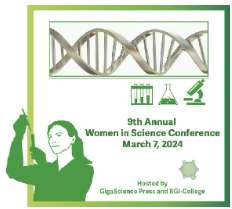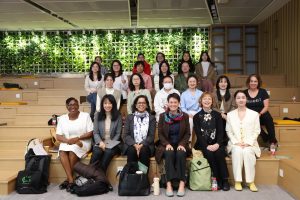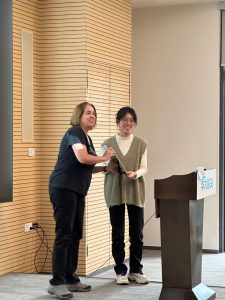Inspiring Inclusion: The 9th Annual Women in Science Conference
The 9th Women in Science Conference took place in Shenzhen. Below are some highlights from the conference co-organized by our Publishing Director, Laurie Goodman, and
Co-Chaired by Doris Yang, from BGI-College.
 Today, March 8, 2024 marks International Women’s Day – where women’s achievement and inclusivity is celebrated. Inspired by the collective awareness of all, this day also raises awareness on bias, discrimination, and gender parity, to name a few. This year’s campaign theme, “Inspire Inclusion” – aims to inspire others to understand what women-inclusion means and the value that arises from that.
Today, March 8, 2024 marks International Women’s Day – where women’s achievement and inclusivity is celebrated. Inspired by the collective awareness of all, this day also raises awareness on bias, discrimination, and gender parity, to name a few. This year’s campaign theme, “Inspire Inclusion” – aims to inspire others to understand what women-inclusion means and the value that arises from that.
Science as a whole has been dominated by males, and over the last decade or so it’s great to see better gender balance across scientific faculty, conferences, as well as journal editorial boards. However, there is still a long way to go; the Matilda Effect still remains – where contributions by women and their scientific achievements are mainly attributed to their male colleagues; along with other barriers and systemic bias. Until now, better mechanisms need to be set in place to minimize this, and to better support women in science.
On the eve of International Women’s Day, women from around the world gathered together at the new BGI headquarters in Shenzhen for the 9th Annual Women in Science conference, hosted by GigaScience Press and BGI College. This was the first in-person meeting since Covid emerged in late 2019, which meant international speakers from outside China could attend in person and directly interact with the young women researchers. It was wonderful to get together, to learn and be inspired by women researchers – with the all-female conference providing a safe place to foster dialogue between young and senior female researchers about science, including career challenges, and how they were met. And most importantly, specific mechanisms that aid female researchers in advancing their careers.
In the opening talk, Minfeng Xiao (Vice Dean, BGI College), highlighted the shared objective is to kindle inspiration among a growing number of young women and female students, especially with the invaluable support of accomplished women in the field. She generally encouraged women in science to think and act autonomously, empowering them to become the individuals they aspire to be. And within the nurturing and supportive community, everyone is urged to express their thoughts and ideas freely.
 This was followed by Laurie Goodman (Publishing Director, GigaScience Press), who highlighted the history and challenges of women in science. Laurie highlighted the Matilda Effect, and other barriers and implicit biases in the STEM work-place culture. An article in the Stanford Social Innovation Review, highlights why it is difficult to retain women in STEM and the lack of diversity, equity and inclusion (DEI), partly due to the “leaky pipeline”. This metaphor is well known, having been around for decades and draws attention to important decision-making moments for women that diverts them from STEM-career paths; such as, starting a family. Such life decisions require women in STEM to be better supported; however, the lack of DEI is not just about these personal choices, but also due to barriers and systemic bias. This article also suggests three strategies to improve DEI for Women of color in STEM that includes: reframing the face of technology, scaling up early career interventions, and reforming recruitment and workplace culture.
This was followed by Laurie Goodman (Publishing Director, GigaScience Press), who highlighted the history and challenges of women in science. Laurie highlighted the Matilda Effect, and other barriers and implicit biases in the STEM work-place culture. An article in the Stanford Social Innovation Review, highlights why it is difficult to retain women in STEM and the lack of diversity, equity and inclusion (DEI), partly due to the “leaky pipeline”. This metaphor is well known, having been around for decades and draws attention to important decision-making moments for women that diverts them from STEM-career paths; such as, starting a family. Such life decisions require women in STEM to be better supported; however, the lack of DEI is not just about these personal choices, but also due to barriers and systemic bias. This article also suggests three strategies to improve DEI for Women of color in STEM that includes: reframing the face of technology, scaling up early career interventions, and reforming recruitment and workplace culture.

Goodman also highlighted the fight against inequality by a biologist, Nancy Hopkins (MIT School of Science), who has been fighting gender inequality on the MIT campus since the early 1970s. Hopkins noticed how routinely her male colleagues took up more of their fair share of resources, such as funding, equipment and lab space. More than a decade later, Hopkins still had less laboratory space than any other senior faculty in the building. One night in 1993, Hopkins got down on her knees with a measuring tape and proved the inequality. Hopkins has spent decades dealing with discrimination and she eventually joined forces with 15 other MIT Female faculty to bring the issue to light. In 1999 they produced “A Study on the Status of Women Faculty in Science at MIT” – the results of which suggest that women were interested in pursuing careers in science but encountered barriers at every step. Hopkins published a book “The Exceptions” – which includes her story along with stories of 15 other female faculty members. This study has led to changes in gender equality and laboratory space around the US.
The overall program consisted of a variety of talks that included scientific research presentations, bridging cultural differences in APAC, and how to apply scientific talents to effective communication and leadership.
 Zhihua Ou (BGI Research, Shenzhen, China) presented her research on the immunopathological landscape of alveolar echinococcosis (AE) using spatial transcriptomics and single-cell RNA sequencing. Her group integrated bulk RNA-seq, scRNA-seq, and ST technologies to reveal the immune characteristics both spatially and chronologically in Echinococcus multilocularis infected mouse liver. They identified some key molecular traits involved in AE development, which may benefit the treatment of echinococcosis.
Zhihua Ou (BGI Research, Shenzhen, China) presented her research on the immunopathological landscape of alveolar echinococcosis (AE) using spatial transcriptomics and single-cell RNA sequencing. Her group integrated bulk RNA-seq, scRNA-seq, and ST technologies to reveal the immune characteristics both spatially and chronologically in Echinococcus multilocularis infected mouse liver. They identified some key molecular traits involved in AE development, which may benefit the treatment of echinococcosis.
Spatial transcriptomics is a new field that takes large-scale data-rich biological and biomedical research into new dimensions – having a significant impact on the fundamental fields of biology and biomedicine. GigaScience Press also has a new cross-journal thematic series in our GigaScience and GigaByte journals on Spatial Omics. You can also read more about this series and ‘method of the year’ technology in our blog.
Other scientific research-based talks were presented by, Professor Jennifer Ann Harikrishna (University of Malaya, Kuala Lumpur, Malaysia), who presented on an miRNA transcriptomic approach to identify stress response genes in Banana; Professor Bolanle Ojokoh (Federal University of  Technology Akure, Nigeria) who presented on their efforts on leveraging technology for public health – using mobile apps and internet of things-based contact tracing. Dr Luo Shujin (Peking University, Beijing, China), presented her work searching for wild cats – from lab to the field – her main theme throughout her research career being genomic diversity, evolution and conservation of wild cats and the Tiger She presented the main findings in tiger study and shared many fascinating stories on domesticated cats and wild cats.
Technology Akure, Nigeria) who presented on their efforts on leveraging technology for public health – using mobile apps and internet of things-based contact tracing. Dr Luo Shujin (Peking University, Beijing, China), presented her work searching for wild cats – from lab to the field – her main theme throughout her research career being genomic diversity, evolution and conservation of wild cats and the Tiger She presented the main findings in tiger study and shared many fascinating stories on domesticated cats and wild cats.
The Keynote speaker was Dr Li Wang (Chinese Academy of Agricultural Sciences, Shenzhen, China), who presented on how the haplotype-phased genome of Ligusticum chuanxiong unveiled the Butylphthalide biosynthesis and homoploid hybrid origin of Ligusticum chuanxiong. By combining different technologies, her lab assembled a haplotype-resolved genome of the species and detected some candidate genes, enzymes and biosynthetic pathway catalyzing interconversion of phthalides. Her study can be regarded as an icebreaker for the dissection of phthalide biosynthetic pathway, revealing the hybrid origin of L. chuanxiong, which will facilitate the metabolic engineering for (S)-3-n-butylphthalide production and breeding for the species.
 The conference also featured a session of young student researchers. In particular, promising female students from BGI were encouraged to apply to speak, especially those who have not had the opportunity to do a formal presentation before. This student session featured presentations from: undergrad student, Dai Shang (Shenzhen, China) who presented on “The Mutual Exclusion of Betalain and Anthocyanin in Caryophyllales Under Multi-Omics”; Masters student, Wei Yilin (BGI Research, Shenzhen, China) who presented on the ‘Development and Application of Large Language Models in Biology”; PhD student Li Li (University of Chinese Academy of Sciences, Beijing, China) presented a “Spatial Transcriptome Map of the Developing Tomato SAM”; and PhD student, Shao Wenwen (BGI, Shenzhen, China) presented on “Path of Technological Innovation by Young Women Scientists”. These early career ladies shared their ongoing projects in life science and their prospects for the future.
The conference also featured a session of young student researchers. In particular, promising female students from BGI were encouraged to apply to speak, especially those who have not had the opportunity to do a formal presentation before. This student session featured presentations from: undergrad student, Dai Shang (Shenzhen, China) who presented on “The Mutual Exclusion of Betalain and Anthocyanin in Caryophyllales Under Multi-Omics”; Masters student, Wei Yilin (BGI Research, Shenzhen, China) who presented on the ‘Development and Application of Large Language Models in Biology”; PhD student Li Li (University of Chinese Academy of Sciences, Beijing, China) presented a “Spatial Transcriptome Map of the Developing Tomato SAM”; and PhD student, Shao Wenwen (BGI, Shenzhen, China) presented on “Path of Technological Innovation by Young Women Scientists”. These early career ladies shared their ongoing projects in life science and their prospects for the future.
Nandita Mullapudi (Bionano, Hong Kong) presented on bridging cultural differences and success in Asia-Pacific and beyond. She highlighted that cultural differences are integral to the scientific community and science will benefit from diversity. She proposed that scientists must equip themselves with tools to succeed in an increasingly diverse setting. In addition, bridging cultural differences involves effort, open-mindedness, risk-taking ability, communication skills and adaptability – with every female scientist having the opportunity to hone and practice these skills.
Liane Siu Slaughter (Clear Water Science Consulting Limited, Hong Kong), presented tips and tricks on how to apply scientific talents for effective scientific  communication and leadership. Liane’s talk was creatively interactive – she ran a poll that required audience participation that encouraged them to think about what the current internal and external obstacles women in STEM are facing right now. She also highlighted how to make some changes, and asked the audience to consider what their options or opportunities are; and how to potentially overcome these obstacles. Fostering discussion and thought of such questions will aid women scientists to apply their scientific talents to effective communication and leadership.
communication and leadership. Liane’s talk was creatively interactive – she ran a poll that required audience participation that encouraged them to think about what the current internal and external obstacles women in STEM are facing right now. She also highlighted how to make some changes, and asked the audience to consider what their options or opportunities are; and how to potentially overcome these obstacles. Fostering discussion and thought of such questions will aid women scientists to apply their scientific talents to effective communication and leadership.
Overall, the day was a success, and the audience received some invaluable take home points that can help them foster their careers – a new hope for better inclusion and equality for Women in STEM. Strategies have been proposed that can aid in promoting diversity, equity, and inclusion (DEI) for women in STEM, and these need to be implemented systematically along with a change in work-place culture.
Above is GigaScience Press, Publishing Director, Laurie Goodman – presenting at the Women in Science session at the ICG18 meeting in Singapore, 2023.
References
Liu L, Dragomirka Jovic D, Laurie Goodman L, A Decade of GigaScience: Women in Science: Past, Present, and Future, GigaScience, Volume 11, 2022, giac069, https://doi.org/10.1093/gigascience/giac069
Hopkins N. A study on the status of women faculty in science at MIT. AIP Conference Proceedings. Vol. 628. No. 1. American Institute of Physics, 2002.
Grogan, K.E. How the entire scientific community can confront gender bias in the workplace. Nat Ecol Evol 3, 3–6 (2019). https://doi.org/10.1038/s41559-018-0747-4